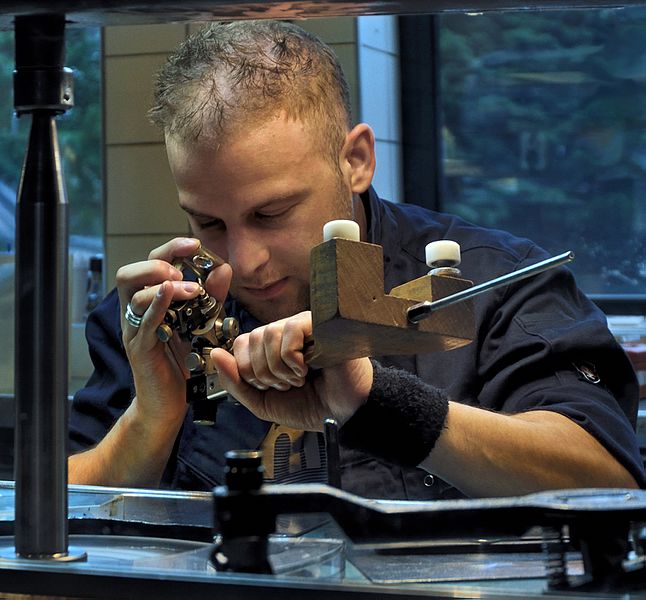Gemology Book Reviews: Careers
Learn how varied gemology careers can be. Our gemology book reviews highlight three different approaches — as art, science, and business.
3 Minute Read
An Anthropologist Among Diamond Cutters
Diamond Stories: Enduring Change on 47th Street. Renee Rose Shield. Ithaca, NY: Cornell University Press, 2002. 256 pp. (Available through Amazon).
This is an anthropological study of Jewish diamond traders in New York written in a freeform, novel-like style. While this approach has worked successfully in the past, here it sorely disappoints.
While the author's stated purpose is to show the complexity of her subject's life, I found the style quite distracting. If you want to learn about a particular subject, like the history of the Jewish people in the diamond trade, you won't find it in a single section but scattered throughout the book.
Others may feel differently about the writing style. However, there's no excuse for the author's misuse of technical terms. For example, Shield writes, "As light interacts with the electrons in the diamond, the light is bent and produces a high refractive index that gives diamonds their high reflectance." Her ignorance of gemological terms hampers her attempt to explain dispersion.
In other instances, the terms used are simply wrong. For example, one picture shows a diamond placed on a lap. The caption says, "Diamond placement on the dop."
Usage problems even appear in quotations. For example, Shield quotes a diamond cutter: "The light goes in and it gets bent, just like when you put a stick in water it looks bent, and that's because of the specific density." It's hard to imagine a diamond cutter making this statement. Specific gravity, or density, is a physical property that has nothing to do with optical response. The diamond cutter must have said refraction. Density and refraction are basic technical terms.
Shield's lack of familiarity with even the basics of gemology hurts her work. This is a shame because there's some interesting information in this book.
A Life in the International Gem Trade
The Gem Merchant: How To Be One, How To Deal With One. David Stanley Epstein. Piermont, NY: Gem Market Publication, 2003. 164 pp. (Available through Amazon).
This is a book that lives up to expectations. The author's 20+ years of experience as a gem dealer on the US and international scenes are evident in his narratives. The author has a harsh, even cynical approach to gem dealing. He has seen many enterprising dealers lose their savings through ignorance. The purpose of Epstein's book is to remove the mystery and show how you can succeed.
He emphasizes that if you can't grade, you can't value. If you can't value, you can't challenge prices. You need to know your bargaining techniques. A subtle mistake in your approach can cost you thousands of dollars. He reveals the best approaches for the regions in which you are buying or selling.
This is a thorough book. Buying, marketing, and manufacturing are covered at great length. Although some of the more technical chapters may make for dry reading, the abundance of anecdotes is delightful. These brief tales of real people and their experiences make the book come to life.
This book is highly recommended for anyone interested in working in the gem trade.
A Gem Carving Legend
Bernd Munsteiner, Reflections in Stone. Wilheim Lindemann, Ed. Germany: Arnoldsche Verlagsanstalt, 2004. 224 pp. (Available through Amazon).
Bernd Munsteiner is one of the greatest gem carvers in history. However, he is known for much more than his technical expertise. He was a pioneer, developing a unique style that set the stage for all contemporary carvers. His crowning creation is his "Metamorphosis" cycle, cut from an 850-kilogram rutilated quartz crystal.
Munsteiner began carving agates, then moved on to transparent gemstones. Even in his early career, his carvings were unique. They took the viewer into delightfully surrealistic worlds or introduced them to imaginary creatures. He dispensed with realism while enhancing the natural beauty and patterns of the stone.
When Munsteiner moved to transparent crystals, he developed more new techniques. Often working with natural inclusions in the stones, he created magical landscapes and spectacular visual spaces. He developed new techniques using light and reflection for optical effects never seen before.
This book is a visual tribute to the master. It has over two hundred color photographs of his carvings. The text is educational, but the stunning images are what make this book stand out. While we can't own or hold these masterpieces, the photographs allow us to delve into his work. This book is highly recommended for anyone who appreciates fine art or gem carving. In Munsteiner's case, the two are inseparable.
International Gem Society
Related Articles
Learn to Use a Polariscope (Video)
Product Review: Duplex II and Rayner Dialdex Refractometers
How to Build a Multipurpose Microscope Stage for Gems
Color Filters: Uses and Limitations for Gemology
Latest Articles
800 Years of Mogok: A Celebration in Tenuous Times
What is the Average Gemstone Faceting Yield?
Pyroxmangite Value, Price, and Jewelry Information
How to Identify Emerald Simulants and Synthetics
Never Stop Learning
When you join the IGS community, you get trusted diamond & gemstone information when you need it.
Get Gemology Insights
Get started with the International Gem Society’s free guide to gemstone identification. Join our weekly newsletter & get a free copy of the Gem ID Checklist!
